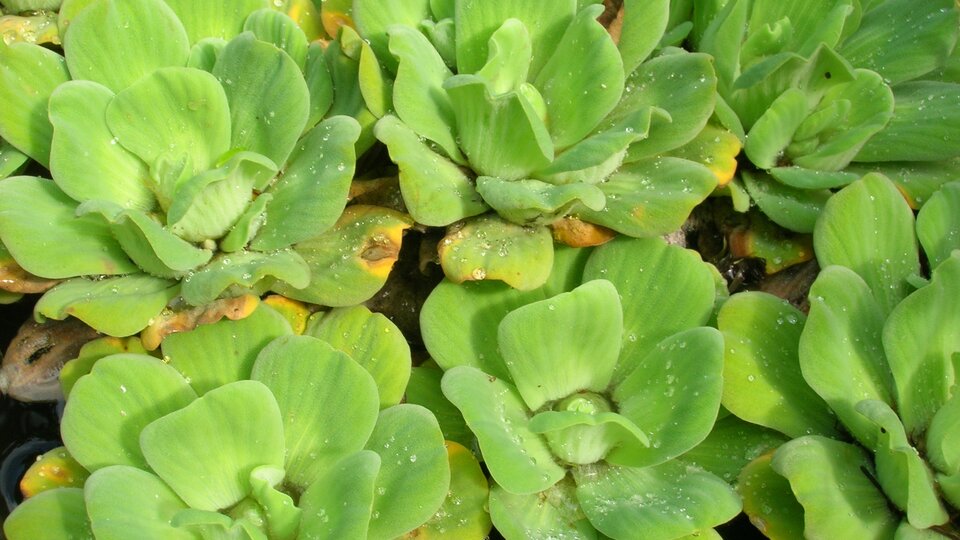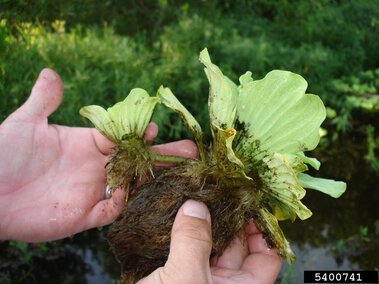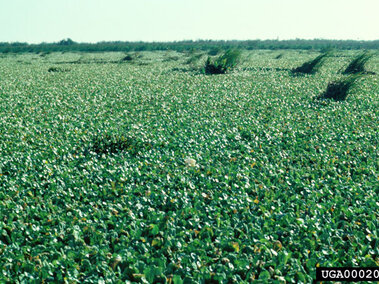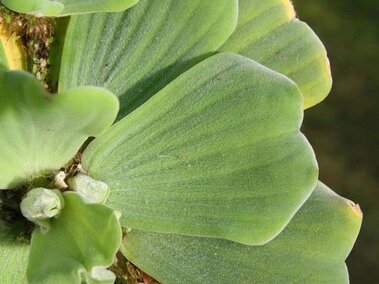General Information
Species Name: Pistia stratiotes
Also Known As: Nile cabbage, river lettuce, shell flower, tropical duckweed, water cabbage
Family: Araceae (Arum Family)
Growth Form: Herb (floating aquatic)
Life Span: Perennial
Flowering Dates: June-September
Origin: Tropical/subtropical regions in North/South America, Australia, Africa, and Asia
Noxious: No, but it is toxic if eaten in large quantities.
Category 1: Potential Aquatic Invasive Species
Why Is It Invasive?
Water lettuce forms dense mats that clog waterways making boating, fishing, and other water activities, impossible. These mats also degrade water quality by blocking the air-water interface and greatly reducing oxygen levels which can result in fish die-off and the overall reduction of aquatic fauna and flora diversity. It can also affect other animal communities by blocking access to the water and/or eliminating spaces the animals depend on for shelter and nesting.
What Does It Look Like?
General Characteristics
Water lettuce is a floating aquatic herb that resembles a floating head of lettuce. It has white to tan, long and feathery roots that hang beneath the rosette of leaves.
Flowers
Inconspicuous; nearly hidden in the center amongst the leaves; on a small stalk, single female flower below and whorl of male flowers above. Blooms in late summer to early winter.
Leaves
Wavy or scalloped margins and are thick, soft, light green, covered with short hairs and water-repellant, can reach up to one foot in length; leaves are attached to one another at the plant’s base to form a free-floating rosette.
Stems
No leaf stems present.
Seeds
A green berry. Each 2 mm-long fruit can contain up to 20 tiny, golden-brown seeds.
Photos

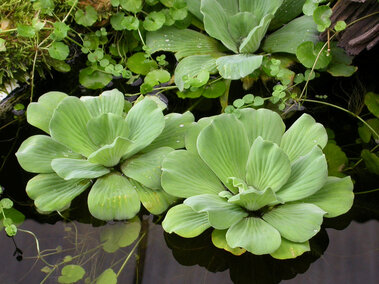

Where Does It Grow?
Water lettuce grows in still waters of ponds, ditches, swamps, and slow-moving streams.
How Does It Spread?
Considered to be one of the most widely distributed aquatic plants globally, its true native distribution is a bit unclear. Its widespread distribution in most countries with a tropical climate may be the result of its ancient use as medicine for humans, as well as its use as fodder for cattle and pigs. Water lettuce spreads rapidly via new daughter plants from horizontally growing stolons, produces copious amounts of viable seed, and can regenerate and start new populations from plant fragments.
How Do I Control It?
Management of invasive aquatic plants involving either mechanical removal of plants or application of herbicides to public waters requires a permit. Contact the Contact the Nebraska Game and Parks Commission for more information.
Mechanical
Removal by hand or machine is a practical control method often used for small areas or when numbers are low. Physical removal should be completed before the flowering and seed set.
Cultural
CLEAN your watercraft, trailer, angling gear and other equipment. Remove all aquatic vegetation and animal species from your equipment.
DRAIN your watercraft at the ramp by removing the boat plug and draining all live wells and ballast tanks.
DRY your watercraft, trailer and other equipment for at least 7 days before visiting another waterbody.
DON'T LET IT LOOSE. Do not release or transport exotic or non-native fish species to new ecosystems, and do not dump aquariums. It is unlawful to release any aquatic species into a waterbody other than the one from which it was harvested. Doing so can promote the spread of AIS.
Chemical
Application of chemicals to public waters requires a permit. Contact the Contact the Nebraska Game and Parks Commission for more information.
What Should I Do If I See It in Nebraska?
If you see water lettuce in Nebraska, you should report it to the Nebraska Game and Parks Commission's Aquatic Invasive Species (AIS) Program using their AIS Report Form. For guidance on what information to include in your report, check out our reporting tips.
References and More Information
Center for Invasive Species and Ecosystem Health
Nebraska Game and Parks Commission
North Carolina Extension Gardener Plant Toolbox
University of Florida Center for Aquatic and Invasive Plants
USDA National Invasive Species Information Center
U.S. Fish & Wildlife Survey Ecological Risk Screening Summary
